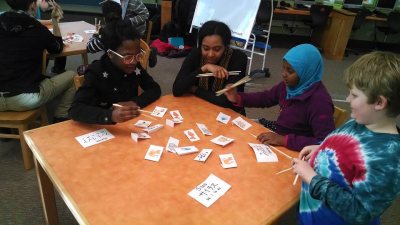A class act: community-engaged learning at Bates
Bates College has long enjoyed a robust partnership with local public schools. In fact, every Education student, in every course, spends at least 30 hours of fieldwork in a K-12 classroom or after-school program. With 250-300 Education students every year, this translates to nearly 10,000 hours spent annually in local public schools and other youth-serving organizations.
Increasingly, Bates faculty from other departments are also teaming up with our K-12 partners to create community-engaged learning experiences that benefit both college students and local youth. Three non-Education courses being offered this semester are a case in point. In Caravans, Khans, and Commissars: A History of Central Eurasia, taught by Professor Wesley Chaney, Bates students are helping teachers at Lewiston High School run a simulation game that will give high school students a deeper understanding of the history of the Silk Road. Using primary sources, Professor Chaney’s students are developing biographical profiles for Silk Road traders, with information about religious beliefs, political systems, family/gender values, as well as what they are trading and why. Students are also creating teaching materials, including a timeline of events, maps, and an annotated bibliography.
In Intermediate Japanese IV, taught by Professor Keiko Konoeda, students are teaching weekly Japanese language and culture classes in after-school programs at both Geiger Elementary School and Lewiston Middle School. Jenn Carter, who oversees after-school programming for Lewiston Public Schools, says, “The classes are going really well from our perspective. The Bates students leading the classes are very creative lesson planners.”

In a recent class, Bates students taught elementary youth the names of various animals by creating a game in which the elementary students, upon hearing the name of an animal, try to be the first to pick up a card depicting that animal with a pair of chopsticks.
Finally, in Marine Science, Professor Katie Dobkowski and her class of 34 students created a “Celebration of Sea Creatures” experience for Lewiston Middle School students. On a chilly day in mid-March, 100 middle schoolers filled the college’s Memorial Commons, rotating among stations featuring a variety of live sea creatures (lobsters, crabs, starfish, plankton, snails) and accompanying interactive games and activities. Says Professor Dobkowski, “I was amazed by the amount of effort my students put in to establishing middle-school appropriate learning goals, designing creative and memorable ways to engage students in achieving those learning goals (from snail “slime” to the echolocation obstacle course), and assessing whether those learning goals were met. I’m so impressed at the ways my students found to communicate marine biology in an engaging and accessible way!” Lewiston Middle School teachers and students shared Professor Dobkowski’s enthusiasm. After the event, literacy teacher Anthony Janetti shared, “I am now in the process of setting up a saltwater aquarium in my classroom, because the kiddos were so inspired!”